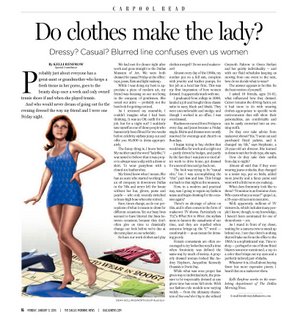Do clothes make the lady? (DMN 1/9/06)

Probably just about everyone has a great-aunt or grandmother who keeps a fresh tissue in her purse, goes to the beauty shop once a week and only owned tennis shoes if and when she played tennis. And who would never dream of going out for the evening dressed the way my friend and I were one Friday night.
We had met for dinner right after work and gone straight to the Dallas Museum of Art. We were both dressed for casual Friday at the office: tops, jeans, flats and light makeup.
While I was doing my best to appreciate a piece of modern art, my friend was focusing on our not being in the company of gentlemen. She noted our attire — probably not the best look for getting noticed.
As I reviewed my ensemble, I couldn't imagine what I had been thinking. It was an OK outfit for my job, but for a night out? I suddenly saw myself as one of those people who has secretly been filmed for two weeks before celebrity stylists jump out and offer you $5,000 to dress appropriately.
The funny thing is, I know better. My mother used the word "ladylike." I was raised to believe that it was proper to always wear a slip with a dress or skirt. To wear pantyhose with a closed-toe leather shoe.
My friend knew what I meant. She has an aunt who started working for an oil company in downtown Dallas in the '50s and never left the house without her hat, gloves, purse and pearls — who only recently switched to knee-high hose when she retired.
Sure, times change, as do our perceptions of what it means to dress for differenct occasions. Yet our busy lives seemed to have blurred the lines between occasions, because they don't often give us time to drastically change our look before we're due at the next place on our schedule.
So have our work clothes and play clothes merged? Do we need makeovers?
Almost every day of the 1980s, my mother put on a full suit, complete with jewelry and leather pumps, for her job at a local law firm. This was my first impression of how women dressed. It apparently stuck with me.
I graduated from college in 2000, landed a job and bought three classic suits in navy, black and khaki. They were uncomfortable and stodgy; and though I worked in an office, I was overdressed.
Slacks soon moved from Fridays to every day, and jeans became a Friday staple. Skirts and dresses were mostly reserved for evenings and church on Sundays.
I began trying to buy clothes that would suffice for work and a night out — partly driven by budget, and partly by the fact that I was just too tired after work to drive home, get dressed for ra second time and go back out.
The look was trying to be "casual chic," but I was accomplishing the "chic" part less and less. This brings me back to that night at the museum.
How, in a modern and practical way, was I going to regain my fashion sense and begin dressing for the occasion again?
There's no shortage of advice on this, and it often comes in the form of makeover TV shows. Particularly on TLC's What Not to Wear, the stylists seem to lament the casualness of our time, and they are repelled when someone brings up the "C" word — comfortable — as an excuse for dressing poorly.
Female contestants are often encouraged to try looks that recall a time when femininity was defined the same way by much of society. A properly dressed woman looked like Audrey Hepburn, Jacqueline Kennedy Onassis or Doris Day.
While what was once proper has given way to individual style, the pressure to be impeccably dressed at any given time has come full circle. With our fashion role models now varying widely — from the ultrasexy characters of Sex and the City to the refined Gwyneth Paltrow to Gwen Stefani and her quirk individuality — and with our fluid schedules keeping us moving from one event to the next, how do we decide what to wear?
The answer appears to be this: Be the best version of yourself.
I asked 10 friends, ages 26-62, what influenced how they dressed. Career remains the driving factor, yet it had more to do with wearing clothes appropriate to specific work environments that still show their personalities, are comfortable and can easily be converted into an evening outfit.
Do they ever take advice from makeover shows? Yes. "I went out and purchased fitted jackets, and it changed my life," says Stephanie, a 26-year-old art director. She learned to dress to suit her body type, she says.
How do they take their outfits from day to night?
Almost all said that if they were wearing jeans or slacks, they changed to a sexier top, put on heels, added more jewelry and a fancy purse and went with a little more eye makeup.
What does femininity look lik to them? "Feminine is as feminine does. Who cares what you wear?" quips LIz, a 39-year-old account executive.
Well, apparently, millions of TV viewers do, which includes many people I know; though, to my knowledge, I haven't been nominated for one of those shows — yet.
As I stand in front of my closet, waiting for a camera crew to sneak up behind me, I see that there's nothing that will take me from the office to the DMA in a sophisticated way. Time to shop — perhaps for one of those fitted blazers someone mentioned, a top in a color that brings out my eyes and a perfectly tailored pair of slacks.
Whatever it is, it's all about buying fewer but more expensive pieces. I heard that on a makeover show.